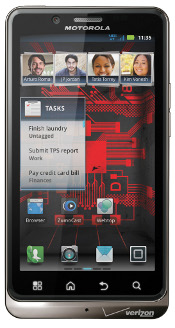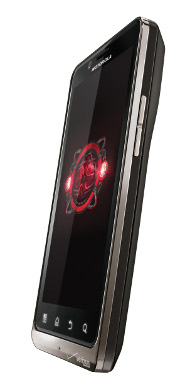Fast processor, 4G push Droid Bionic to the top, says review
Sep 12, 2011 — by LinuxDevices Staff — from the LinuxDevices Archive — 2 viewsThe Android 2.3.4-powered Droid Bionic by Motorola is the company's fastest smartphone yet, and it runs on Verizon's LTE network, the fastest 4G service in the U.S. Although one pays dearly for the Bionic's blazing speed, both in price and in poor battery life, the Bionic will more than compensate for those seeking top performance, says this review.
Android smartphone OEMs have pumped out so many handsets based on the open source operating system — more than 300 varietals worldwide — that many of the latest handsets offer incremental improvements over their predecessors. While the Droid Bionic looks like an modest improvement over earlier Droid phones on the outside, it has taken a giant step internally.
Since Verizon Wireless launched the Motorola Droid in November 2009, it has released two Droid updates, each time offering incremental improvements over the first smash-hit Motorola Android phone. Verizon's popular Motorola Droid X begat a somewhat disappointing Droid X2 earlier this year.
 Verizon's Android 2.3.4 ("Gingerbread") based Motorola Droid Bionic (pictured) is not a Droid X, but could certainly pass for one, possessing a similar hardware design, albeit with an improved aesthetic. The Droid X and Bionic both have 4.3-inch screens for big multimedia consumption.
Verizon's Android 2.3.4 ("Gingerbread") based Motorola Droid Bionic (pictured) is not a Droid X, but could certainly pass for one, possessing a similar hardware design, albeit with an improved aesthetic. The Droid X and Bionic both have 4.3-inch screens for big multimedia consumption.
Both phones weigh about 5.5 ounces and, at 0.43 inches, are thicker than the average smartphone. The sides of the devices have similar features, including the curved neck of each handset to allow for the eight-megapixel camera, as well as micro-USB and HDMI ports. The Bionic has more of a curve, while the Droid X has an awkward bump.
It's what's under the hood that blows the doors off of any comparison. With a 1GHz, single-core processor on Verizon's 3G network, the Droid X is not a bad handset. That is, until you pick up the Bionic, power it on, and begin accessing applications.
Powered by a 1GHz dual-core processor, and running on Verizon's 4G Long Term Evolution (LTE) 4G network, the Bionic proved twice as fast for downloading and accessing applications as the Droid X. I easily saw 10Mbps to 12Mbps download speeds, and 5Mbps upload speeds with the Bionic.
On the Bionic, I downloaded, installed, and opened Google+ for Android in 22 seconds, compared with the 44 seconds to get the app up and running on my Droid X. YouTube videos loaded fast and looked great, thanks to the Bionic's Quarter High Definition (qHD) 960 x 540-pixel display (vastly superior to the Droid X's own WVGA screen, which has a resolution of 854 x 450).
While the Droid X seemed like a great multimedia handset to me last summer, the Bionic puts it to shame, and not just for the app download speed. This device sheds the stuttering issue the Droid X's camera had early on, which caused unfortunate latency between photo snaps.
The video camera boasts 1080p HD and audio, compared with just 720p video capture with the Droid X. The front-facing camera capably enables video chat over 4G LTE, 3G, or Wi-Fi. Voice calls were clear thanks to the dual speakers positioned at the top and bottom of the handset.
The Droid Bionic offers a mighty 1GB of RAM, as well as 16GB each of internal and microSD storage. All the expected wireless features are available as well. (See our earlier Droid Bionic coverage for more technical details.)
Apps and accessories
The Bionic comes preinstalled with a few cool business-oriented apps, including the Citrix GotoMeeting web-conferencing app and Citrix Receiver remote desktop app for Android. There's also Motorprint for letting users print from the phone to any Wi-Fi-enabled printer. These apps worked as advertised.
 On the consumer front, ZumoCast is a cool, new Motorola app that lets consumers stream their music, photos, and videos from their computer to the Bionic via cloud-based software.
On the consumer front, ZumoCast is a cool, new Motorola app that lets consumers stream their music, photos, and videos from their computer to the Bionic via cloud-based software.
The handset also follows the Motorola Atrix 4G and Photon 4G in including Motorola's Webtop app, which features a full Mozilla Firefox 4 web browser to flash phone files, dialer, and other data to a special barebones, netbook-like Motorola Lapdock accessory, or a separately available HD Station which can display content on an attached HDTV.
I did not test the Lapdock on the Bionic, but have tested the original version on the Atrix 4G. The problem with the Lapdock is that it costs $300. However, consumers can get a $100 rebate if they buy the Bionic and Lapdock at the same time and sign up for a minimum $50, 5GB per month data plan.
What won't you like about the Bionic? Like the Droid X, the rectangular, boxy shape of the Bionic resembles more a miniature tablet than a smartphone. If you like that, great. If not, go for something more rounded, such as the Samsung Droid Charge or even the HTC Thunderbolt, both muscular 4G LTE phones from Verizon.
Also, the Bionic's 1735mAh battery dies quickly thanks to the combination of Verizon's 4G LTE network and the dual-core chip. It just takes a lot of power to fuel this level of application performance. Motorola claims over 11 hours of talk time for the Bionic, but I got maybe 3.5 to four hours of hardcore multimedia use. Try watching the Netflix app for Android: You can watch one two -hour movie before requiring a recharge.
And the Bionic is not cheap. At $300 on contract, it's as expensive a subsidized phone as you're going to find on the U.S. market today, joining the Droid Charge when it was launched earlier this spring at the same price.
Have no fear though — if the Bionic doesn't start off strong, expect Verizon to chop it by $50 or $100 or even more. If power and speed are the most important, the price likely won't matter. After all, this is the fastest smartphone we've ever experienced on Verizon's charged-up 4G LTE network.
Clint Boulton is a writer for eWEEK.
This article was originally published on LinuxDevices.com and has been donated to the open source community by QuinStreet Inc. Please visit LinuxToday.com for up-to-date news and articles about Linux and open source.